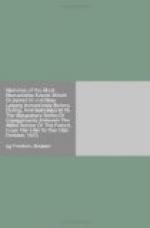The action commenced in the centre of the French army beyond Probstheide, probably with the storming of the villages in its front, for we afterwards learned that they were several times taken and recovered. They have been more or less reduced to heaps of rubbish. That the work of slaughter might be completed on this day, it had been begun with the first dawn of morning. So early as nine o’clock all the immense lines from Taucha to Konnewitz were engaged. As the latter village lay nearest to us, we could see what was passing there the most distinctly. From Loesnig, a village situated beyond Konnewitz, a hollow, about two thousand paces in length, runs from north-west to south-east. It is bordered with a narrow skirt of wood, consisting of alders, limes, and oaks, and forms an angle with the village. Beyond this line were advanced several French batteries, the incessant movements of which, as well as every single shot, might be clearly distinguished with our glasses. To make myself better acquainted with this neighbourhood, I explored two days afterwards this part of the field of battle, and found that the French artillery must there have formed an open triangle; for the road which runs straight from Leipzig, behind Konnewitz through Dehlis and Loesnig, of course from north to south, was also lined by French batteries. The houses of those villages had served them for a point d’appui in the rear, and were most of them dreadfully shattered by the balls of the Austrians. The artillery of the latter seems to have had a great advantage in regard to the ground. The French cannon brought into the line from Konnewitz to Dehlis and Loesnig stood in a hollow—those of the Austrians on eminences. These last had moreover the advantage of enfilading the two angles formed by the batteries of the French. That this had actually been the case was evident from the numbers of French cannoniers and horses lying dead in rows in the line of the above-mentioned villages, where they had been swept down by the guns of their opponents. On the eminences where the hostile cannon were planted the number of dead was much smaller, and these were apparently not artillery-men, but infantry, who were probably engaged in covering those batteries. The firearms which lay beside them confirmed the conjecture. This pass must nevertheless have been obstinately defended, as it was not taken the whole day. The fire of musketry grew more and more brisk—a proof that the combatants were already in close action. The French tirailleurs could not be driven out of the woods, on which their right wing was supported. We remarked frequent charges of cavalry, which seemed to decide nothing. All the villages lying beyond Konnewitz, on the road to Borna, as far as Markleeberg, were on fire. The thunder from the French centre, as well as from the left wing, gradually approached nearer to the city. The seventh corps, under general Reynier, was in the left wing, and posted towards




